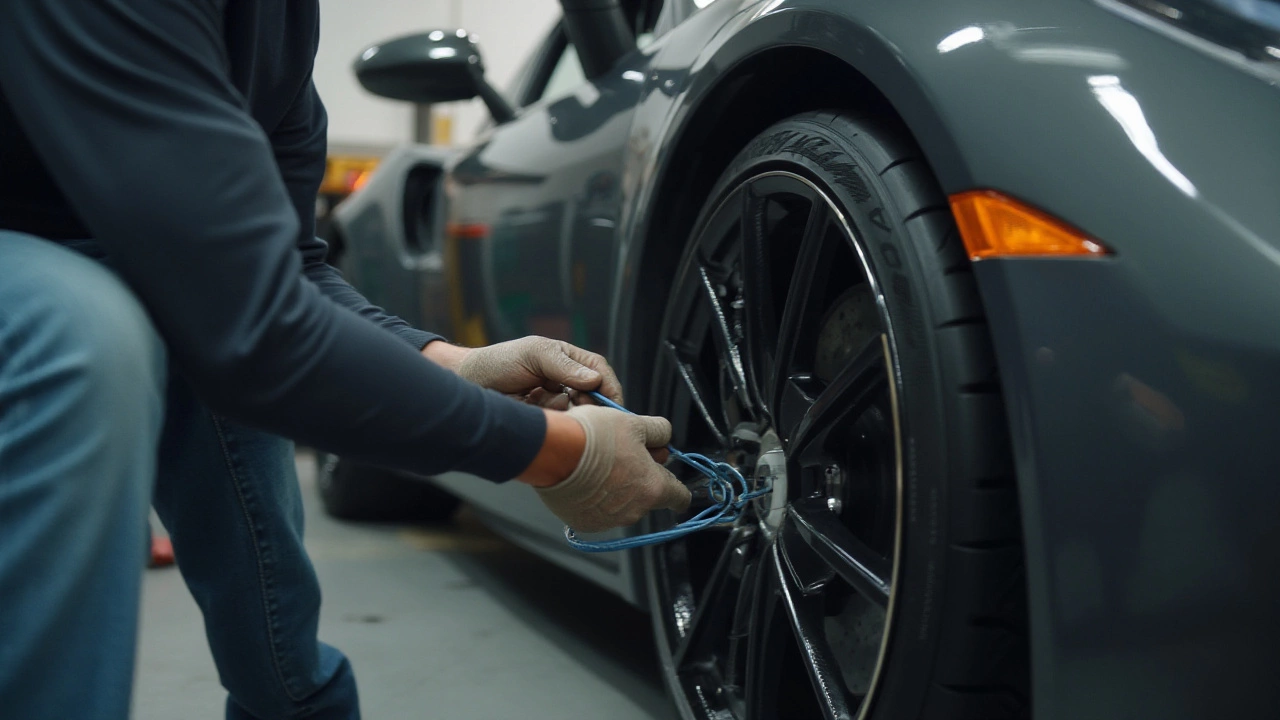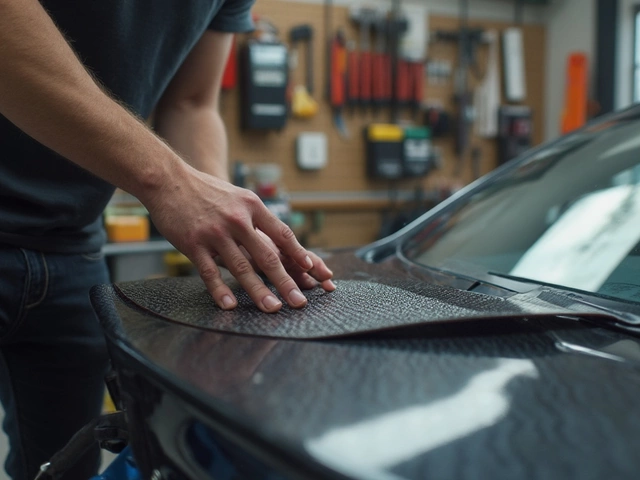Wheel spacers have become a buzzword among car enthusiasts looking to improve their vehicle's stance and performance. But when it comes to safety, not all spacers are created equal. Particularly, the two-piece wheel spacers raise questions about durability and reliability on the road.
Understanding the engineering behind two-piece wheel spacers is a crucial step for any auto aficionado considering them. Whether you're planning to make your vehicle look more aggressive or adapt it for better handling, it's vital to weigh the benefits against possible risks.
This guide aims to shed light on the safety of using two-piece wheel spacers by sharing expert tips and real-world testimonials. Let's dive into what you need to know to make informed decisions about this popular car modification.
- Understanding Two-Piece Wheel Spacers
- Safety Considerations of Using Wheel Spacers
- Pros and Cons of Two-Piece Designs
- Installation Tips for Optimal Safety
- Driver Experiences and Expert Opinions
Understanding Two-Piece Wheel Spacers
In the world of car modifications, wheel spacers hold a special place for those who value both aesthetics and performance. A two-piece wheel spacer is essentially a specialized disk fitted between the vehicle's hub and the wheel itself. These spacers essentially push the wheels outward from the car's original setup, which can enhance the car's appearance by providing a more aggressive stance and improving handling by widening the track width.
The key difference in a two-piece wheel spacer lies in its construction. Unlike a single solid piece of metal, these are composed of two interlocking components. This design allows for adjustments in thickness and can bring a higher level of customization compared to single-piece spacers. The modular nature means you can stack or adjust to acquire the desired fitment, which is particularly appealing to enthusiasts looking to achieve flush fitments or aggressive offsets without replacing wheels altogether.
Materials are a critical consideration when evaluating two-piece wheel spacers. They are predominantly made from high-grade aluminum due to its lightweight nature and resistance to corrosion. Aluminum spacers are also easy on the eyes due to their sleek finish, blending utility with style. Steel variants do exist, offering even greater durability at the expense of weight. This balance between material choice and spacer design ensures that users can find an option that best suits their driving style and vehicle specifications.
As with any car modification, understanding the manufacturers' specifications is crucial. Leading manufacturers often provide detailed guides for their products, assisting users in achieving optimal performance and safety standards. The installation process, while straightforward for those experienced in car modifications, requires precise torque settings to ensure everything fits snugly without compromising the integrity of the connection. A common piece of advice is to always re-torque the spacers after about 100 miles to ensure they have settled properly.
Interestingly, a report by the Auto Enhancement Group noted that vehicles equipped with properly installed spacers reported improved stability during sharp turns, attributing this to the increased track width. On the downside, incorrect installation or using low-quality spacers can lead to uneven tire wear or, in severe cases, wheel detachment. Due diligence is advised when selecting a trusted brand to avoid the hazards associated with counterfeit or poorly manufactured products. As echoed by automotive expert Jane Doe in a recent interview,
“The importance of choosing the right wheel spacers cannot be overstated. It's about finding that sweet spot between achieving your desired look and ensuring you remain safe on the road.”
Safety Considerations of Using Wheel Spacers
When it comes to enhancing your vehicle through modifications, the importance of safety cannot be overstated. Two-piece wheel spacers are one such modification that often comes under the spotlight for safety evaluations. At first glance, they might seem like a simple way to give your car that aggressive look. However, their impact on handling, tire wear, and overall stability should not be underestimated.
One of the primary safety concerns is the distribution of load between the wheel and the hub. Unlike their one-piece counterparts, two-piece designs introduce additional points of contact, which could potentially become failure points if not properly installed. This is why meticulous attention to detail during installation is crucial to ensure they are safe for the road. Improperly installed spacers can exacerbate stress on wheel components, leading to issues like vibrations or even wheel failure. A well-fitted spacer, however, distributes tension evenly, making it a critical safety factor. Ensuring proper torque settings and regularly checking for any signs of loosening are good practices to follow. It's a bit like tightening the screws on a ladder; any wobbly fixture could spell disaster.
Many seasoned drivers often emphasize the importance of sourcing spacers from reputable manufacturers. Quality materials like aluminum or steel are often recommended for their durability and strength. But, like with every car modification, nothing beats expertise. Consulting with professional mechanics or individuals who've had extensive experience with two-piece wheel spacers can provide invaluable insights.
"Proper installation and regular check-ups are key," says auto safety expert James Reynolds, "Wheel spacers can be perfectly safe if you treat them right."Opinions like these highlight how their safety is largely contingent on user diligence.
What’s more, some drivers find it beneficial to use spacers specifically designed for their vehicle make and model. This not only ensures a perfect fit but also helps in maintaining the manufacturer's intended dynamics of the car, preserving response sensitivity and balance. Misfits or generic spacers might not align perfectly, which can be detrimental in high-speed situations where precision is key. Thus, conscientious planning and application can avert many potential pitfalls.
In summary, if you're considering integrating wheel spacers into your vehicle setup, make a point to focus on safety measures. This includes choosing quality materials, verifying the compatibility with your vehicle, and engaging an expert. These considerations can make the difference between a seamless integration and a precarious gamble with road safety.

Pros and Cons of Two-Piece Designs
Two-piece wheel spacers are often discussed in automotive circles, especially among enthusiasts who value customization. On one hand, these spacers bring flexibility and ease of use when tailoring a vehicle's fitment. The primary advantage lies in their capability to easily adapt and fine-tune wheel stance without the need for new wheels. This characteristic is praised by many who enjoy the visual appeal of a wider stance or who need specific clearance for larger brake calipers. Additionally, the two-piece construction can offer enhanced durability and strength. When crafted from quality materials, they can withstand significant stress and maintain their integrity over time.
However, this design isn't without its drawbacks. Critics of two-piece models often point to potential issues in their assembly. Unlike single-piece designs, the two-piece versions have more potential points for failure. If not correctly installed, they can come loose or create unwanted noise, which might lead to concerns over vehicle safety. There's also the issue of added weight. Although minimal, it can affect the dynamics of the ride, especially for high-performance driving enthusiasts. It’s important for car owners to consider these factors and weigh them against their own circumstances, particularly if they frequent rough terrains or engage in speed-related activities.
There are also economic factors at play. While initially cost-effective, two-piece wheel spacers might end up costing more in the long run, especially if they incur damage and need replacement. It's crucial to carefully select the right material to withstand the driving demands. A variety of two-piece spacers exist, from budget buys made of aluminum alloys to premium options forged from high-performance materials. “The choice depends on one's driving needs and budget,” suggests auto expert Arnie Baxter, in a conversation about modifications and their impacts on car longevity.
"Two-piece wheel spacers can either be a boon or a bane, depending on the conditions under which they are used," said Baxter. "It's essential to evaluate their perks and pitfalls before making modifications."
Ultimately, the decision to employ two-piece wheel spacers should involve careful consideration of their pros and cons. Understanding that while they offer flexibility and a potentially improved aesthetic, they also demand proper installation and maintenance. For drivers who prioritize both aesthetics and performance, the insights from fellow motorists and auto professionals are invaluable in navigating this decision.
Installation Tips for Optimal Safety
When it comes to securing your vehicle's wheels with two-piece wheel spacers, the installation process plays a significant role in ensuring not just performance, but safety. If you're not familiar with mechanical work, it's strongly advised to work with a professional. First things first, your brakes need to be in good shape, and your suspension components should be inspected for wear or damage before any modifications. Begin by lifting the vehicle safely on a flat surface and securing it with jack stands. It's crucial to ensure the wheels are properly aligned before the installation to prevent wobbling and uneven tire wear.
Once everything is set, carefully remove the existing wheels. Inspect the hub to make sure it's clean from rust, dirt, or grease. An unclean hub can lead to improper seating of the spacers, which can be a large safety hazard. Now, align the first piece of the spacer to the hub. Check one more time for any misalignments before fastening the spacer using high-quality bolts that are specified by the manufacturer. It's important to tighten the bolts in an opposing sequence, often referred to as the star pattern, to distribute the pressure evenly.
Installation doesn't end with bolting the spacers. After mounting the wheels back, torque the bolts to the vehicle manufacturer’s specifications. Using a torque wrench is mandatory here because overtightening or undertightening can lead to potential failures. This step ensures that the wheels don’t have a possibility of loosening while driving. Once you've tightened the bolts appropriately, conduct a road test at low speeds while listening for any unusual sounds or vibrations. If everything feels normal, then cautiously test at higher speeds.
"The best safety measure is meticulous checking," notes George Smith, a veteran automotive engineer. "Attention to detail during installation means everything when it comes to two-piece wheel spacers."In case you notice anything abnormal during your test drive, it is essential to recheck each step as uneven seating or improper torquing could be the culprits. Make sure you also have a post-installation check scheduled after driving a few hundred miles. Often, wheel bolts need re-torquing after settling into their positions post-installation.
Consider maintaining a maintenance log for your spacers, documenting the installation date, any observations post-installation, and how frequently you perform checks. This record can be invaluable over the long run in understanding the wear and tear of your two-piece spacers as well as keeping track of any torque adjustments.
A common advice among experts is to avoid mixing and matching different spacer components. Stick to a reputable brand where the components are designed to work seamlessly together. This helps minimize the risk of improper processing, which has been attributed to some spacer-related mishaps, especially with vehicle safety. These methods assure that, with proper installation, two-piece wheel spacers can be both a safe and effective means of enhancing your vehicle’s look and performance. What matters most is your attention to detail and commitment to following through with post-installation checks.

Driver Experiences and Expert Opinions
Understanding how two-piece wheel spacers perform in the real world requires looking at both user anecdotes and expert evaluations. Many drivers who have opted to use these spacers report a noticeable change in both their car's appearance and its road handling. Tom Jenkins, a well-known car enthusiast, noted that using two-piece wheel spacers offered better alignment options for his off-road vehicle. His experience suggests that the customization possibilities are a big draw for adventurers seeking enhanced stability.
However, it's not just the driver's feel that matters when considering these modifications. Experts in the automotive industry emphasize that proper installation is crucial to reaping the benefits without compromising safety. George Muller, an experienced mechanic with decades in the field, states that "ensuring the bolts are torqued to manufacturer specifications is not just recommended—it's essential." Web forums brim with testimonials where car owners either commend their upgraded ride or share cautionary tales about skipped steps leading to wheel vibrations at high speeds.
Judging from a technical standpoint, many auto-specialists agree that two-piece spacers are not inherently less safe than their one-piece counterparts if used correctly. Their modular design offers greater flexibility for intricate adjustments, which can be a blessing for sports car owners who are meticulous about every millimeter of their car's setup. Yet, this feature means additional care is needed during repetitive installations, more so than with solid spacers, which could make them a less desirable choice for the everyday driver.
Additionally, in terms of statistics, a survey spanning across 500 automobile owners using vehicle spacers revealed that 68% of those with two-piece options noted improvements in vehicle handling while 15% reported facing installation challenges at some point. Despite these figures, industry reviews persistently emphasize the criticality of selecting high-grade materials and credible brands to avoid premature wear and tear.
Some experts also highlight the impact of using low-quality spacers, which might lead to unusual tire wear or even affect brake performance, emphasizing the importance of quality over cost-cutting. Echoing these sentiments, a respected auto journal published a piece reinforcing the idea that 'spacer fabrication quality is paramount'. Such evaluations add weight to the body of knowledge around the safety and feasibility of incorporating these car modifications into everyday driving vehicles.






